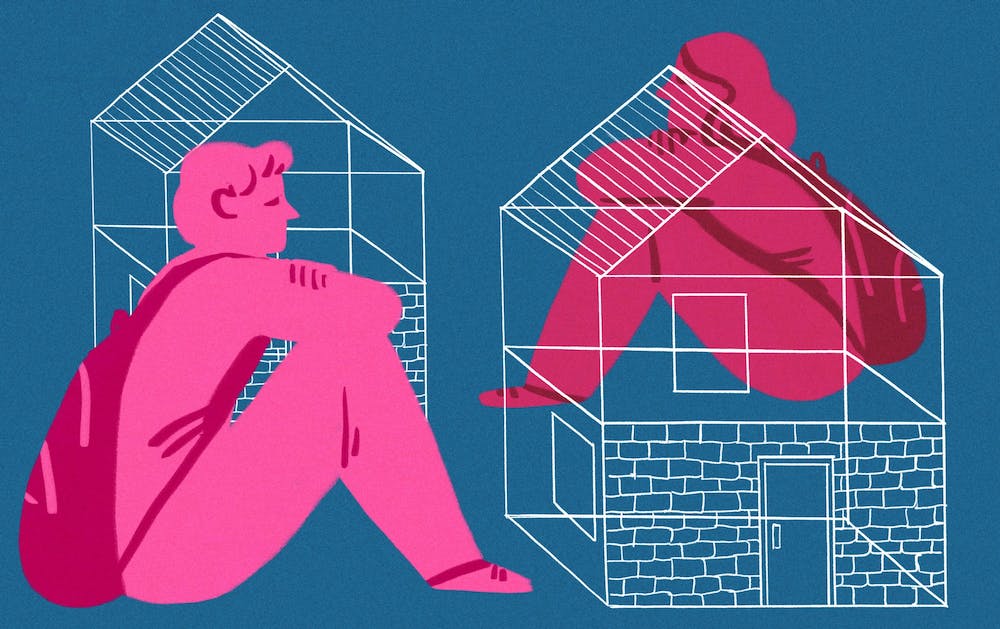THE SCHOLARS PROGRAM
1st Annual
Scholars Program
Scholarships:
- $5,000 First Place
- $2,500 Second Place
- $1,500 Third Place
Judges from:
- Duke
- Stanford
- UCLA
- Harvard

The issue we are addressing: Homelessness
- 100+ million people around the world are homeless
- An estimated 500,000 of the US is homeless
- In the US there is about 20% of homeless that are under 18 years old
- Not enough low income housing available
- Health and homelessness are linked
- Housing can greatly help improve someones health and keep them safe
Challenge Overview:
- In this competition, you will try to use architecture, construction, and engineering properties to design the best solution to combat homelessness. You will present your design creatively.
- Recommendations include PowerPoint, Keynote, video, print, 3D model online, Google site, or other creative methods.
- Key criteria that you will be judged on include economics, sustainability, community impact, aesthetics and innovation, achievability, and type of living situation.
- The competition is open to all females in middle and high school. To apply, become a buildgirls member free of charge!
- There will be three rounds over the course of the school year and each round will have eliminations. During the last round three winners will be chosen.
KEY DATES:
First Round: February 2024
Second Round: April 2024
Final Round: June 2024

Challenge Details:
- Economics (materials, cost)
- You will be judged on how cost-effective and affordable your design can be. You must consider the cost of materials and any other design features like furniture you choose to add. In addition, you will need to consider and think about how much it would cost to buy and maintain the home.
- Type of living situation
- There are multiple types of housing and housing situations. In this section, you will need to identify or choose the type of housing for your design. Type of housing situations include how many people can live there? What is the profile of the person/people living there? Is it an apartment design, condo, or house? Be creative, too if you have a different type of housing situation or housing type, just make sure to specify it and explain it.
- Community Impact
- In this section, you will be judged on how your design affects the community it lives in. You will need to identify where your house will be (will it be in a neighborhood or a more rural area?). You will also need to consider the look of it.
- Sustainability
- In this section, you will be judged on how sustainable your design is. In this section, sustainability is not about its impact on the environment but rather how sustainable your house is to its user(s). How long will they be able to live there? Will they need to update it and change appliances, etc.?
- Aesthetics and innovation
- In this section you will be judged on how your design looks and how creative it is. Remember the creativity can be part of the architecture of your structure or the presentation or even the design. For this section you have creative freedom so anything that you want to design or add is up too you!
- Achievability
- In this section you will be judged on how achievable your design is. For example a 4,000 square foot home is not achievable but a home that is 1,500 square feet would be more achievable. Think how probable your design would be in todays world and how easy it would be to construct it.
- Presentation style:
- It is up to you on how you would like to present but be creative! Examples of presentation ideas include a powerpoint, online or real 3d model, blueprint drawings, etc.




THE SCHOLARS PROGRAM
1st Annual
Scholars Program
Scholarships:
$5,000 First Place
$2,500 Second Place
$1,500 Third Place
Judges from:
Duke
Stanford
UCLA
Harvard

The issue we are addressing: Homelessness
- 154 million people around the world are homeless
- An estimated 18% of the US is homeless
- In the us there is about 4.2 million youth who are homeless
- Not enough low income housing available
- Health and homelessness are linked
- Housing can greatly help improve someones health and keep them safe
Challenge Overview:
- In this competition, you will try to use architecture, construction, and engineering properties to design the best solution to combat homelessness. You will present your design creatively.
- Recommendations include PowerPoint, Keynote, video, print, 3D model online, Google site, or other creative methods.
- Key criteria that you will be judged on include economics, sustainability, community impact, aesthetics and innovation, achievability, and type of living situation.
- The competition is open to all females in middle and high school. To apply, become a buildgirls member free of charge!
- There will be three rounds over the course of the school year and each round will have eliminations. During the last round three winners will be chosen.
KEY DATES:
First Round: January 2024
Second Round: March 2024
Final Round: May 2024
Second Round: March 2024
Final Round: May 2024

Challenge Details:
- Economics (materials, cost)
- You will be judged on how cost-effective and affordable your design can be. You must consider the cost of materials and any other design features like furniture you choose to add. In addition, you will need to consider and think about how much it would cost to buy and maintain the home.
- Type of living situation
- There are multiple types of housing and housing situations. In this section, you will need to identify or choose the type of housing for your design. Type of housing situations include how many people can live there? What is the profile of the person/people living there? Is it an apartment design, condo, or house? Be creative, too if you have a different type of housing situation or housing type, just make sure to specify it and explain it.
- Community Impact
- In this section, you will be judged on how your design affects the community it lives in. You will need to identify where your house will be (will it be in a neighborhood or a more rural area?). You will also need to consider the look of it.
- Sustainability
- In this section, you will be judged on how sustainable your design is. In this section, sustainability is not about its impact on the environment but rather how sustainable your house is to its user(s). How long will they be able to live there? Will they need to update it and change appliances, etc.?
- Aesthetics and innovation
- In this section you will be judged on how your design looks and how creative it is. Remember the creativity can be part of the architecture of your structure or the presentation or even the design. For this section you have creative freedom so anything that you want to design or add is up too you!
- In this section you will be judged on how your design looks and how creative it is. Remember the creativity can be part of the architecture of your structure or the presentation or even the design. For this section you have creative freedom so anything that you want to design or add is up too you!
- Achievability
- In this section you will be judged on how achievable your design is. For example a 4,000 square foot home is not achievable but a home that is 1,500 square feet would be more achievable. Think how probable your design would be in todays world and how easy it would be to construct it.
- In this section you will be judged on how achievable your design is. For example a 4,000 square foot home is not achievable but a home that is 1,500 square feet would be more achievable. Think how probable your design would be in todays world and how easy it would be to construct it.
- Presentation style:
- It is up to you on how you would like to present but be creative! Examples of presentation ideas include a powerpoint, online or real 3d model, blueprint drawings, etc.





